Related Research Articles

The 1968 Democratic National Convention was held August 26–29 at the International Amphitheatre in Chicago, Illinois, United States. Earlier that year incumbent President Lyndon B. Johnson had announced he would not seek reelection, thus making the purpose of the convention to select a new presidential nominee for the Democratic Party. The keynote speaker was Senator Daniel Inouye of Hawaii. Vice President Hubert Humphrey and Senator Edmund Muskie of Maine were nominated for president and vice president, respectively. The most contentious issues of the convention were the continuing American military involvement in the Vietnam War and voting reform, particularly expanding the right to vote for draft-age soldiers who were unable to vote as the voting age was 21. The convention also marked a turning point where previously idle groups such as youth and minorities became more involved in politics and voting.
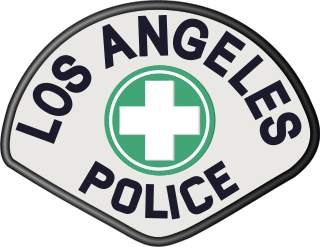
The Los Angeles Police Department (LAPD), officially known as the City of Los Angeles Police Department, is the primary law enforcement agency of Los Angeles, California, United States. With 8,967 officers and 3,000 civilian staff, it is the third-largest municipal police department in the United States, after the New York City Police Department and the Chicago Police Department.
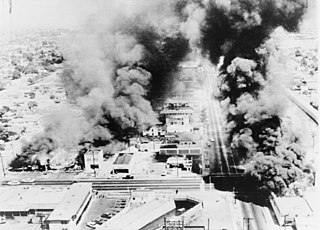
The Watts riots, sometimes referred to as the Watts Rebellion or Watts Uprising, took place in the Watts neighborhood and its surrounding areas of Los Angeles from August 11 to 16, 1965.

Daryl Francis Gates was an American police officer who served as chief of the Los Angeles Police Department from 1978 to 1992. His length of tenure in this position was second only to that of William H. Parker. Gates is credited with the creation of SWAT teams alongside fellow Los Angeles Police Department (LAPD) officer John Nelson, who others claim was the originator of SWAT in 1965. Gates also co-founded the Drug Abuse Resistance Education program.
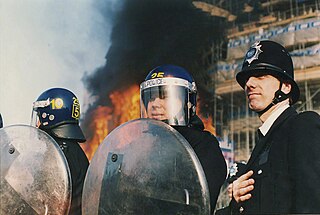
The poll tax riots were a series of riots in British towns and cities during protests against the Community Charge, introduced by the Conservative government of Prime Minister Margaret Thatcher. The largest protest occurred in central London on Saturday 31 March 1990, shortly before the tax was due to come into force in England and Wales.

The 1992 Los Angeles riots were a series of riots and civil disturbances that occurred in Los Angeles County, California, United States, during April and May 1992. Unrest began in South Central Los Angeles on April 29, after a jury acquitted four officers of the Los Angeles Police Department (LAPD) charged with using excessive force in the arrest and beating of Rodney King. The incident had been videotaped by George Holliday, who was a bystander to the incident, and was heavily broadcast in various news and media outlets.

The Chicano Moratorium, formally known as the National Chicano Moratorium Committee Against The Vietnam War, was a movement of Chicano anti-war activists that built a broad-based coalition of Mexican-American groups to organize opposition to the Vietnam War. Led by activists from local colleges and members of the Brown Berets, a group with roots in the high school student movement that staged walkouts in 1968, the coalition peaked with a August 29, 1970 march in East Los Angeles that drew 30,000 demonstrators. The march was described by scholar Lorena Oropeza as "one of the largest assemblages of Mexican Americans ever." It was the largest anti-war action taken by any single ethnic group in the USA. It was second in size only to the massive U.S. immigration reform protests of 2006.
Bloody Christmas was the severe beating of seven civilians by members of the Los Angeles Police Department (LAPD) on December 25, 1951. The attacks left five Mexican American and two white young men with broken bones and ruptured organs, and were properly investigated only after lobbying from the Mexican American community. The internal inquiry by Los Angeles Chief of Police William H. Parker resulted in eight police officers being indicted for the assaults, 54 being transferred, and 39 suspended.

On 15 February 2003, a coordinated day of protests was held across the world in which people in more than 600 cities expressed opposition to the imminent Iraq War. It was part of a series of protests and political events that had begun in 2002 and continued as the invasion, war, and occupation took place. The day was described by social movement researchers as "the largest protest event in human history".

The Vancouver Police Department (VPD) is the police force in Vancouver, British Columbia, Canada. It is one of several police departments within the Metro Vancouver Area and is the second largest police force in the province after RCMP "E" Division.
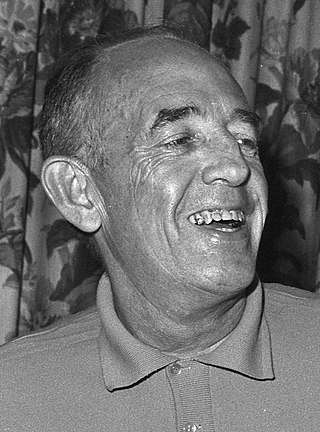
William Henry Parker III was an American law enforcement officer who was Chief of the Los Angeles Police Department (LAPD) from 1950 to 1966. To date, he is the longest-serving LAPD police chief. Parker has been called "Los Angeles' greatest and most controversial chief of police". The former headquarters of the LAPD, the Parker Center, was named after him. During his tenure, the LAPD was known for police brutality and racism; Parker himself was known for his "unambiguous racism".

The Los Angeles Police Department (LAPD) was formed in 1869, and has since become the third-largest law enforcement agency in the United States. They have been involved in various events in history, such as the Black Dahlia murder, the Watts riots, the 1992 Los Angeles riots, the North Hollywood shootout, the murder trial of O. J. Simpson, and the Rampart scandal.
Crime in Los Angeles has varied throughout time, reaching peaks between the 1970s and 1990s. Since the early 2020s, crime has increased in Los Angeles.

The 1968 Democratic National Convention protests were a series of protests against the United States' involvement in the Vietnam War that took place prior to and during the 1968 Democratic National Convention in Chicago, Illinois. The protests lasted approximately seven days, from August 23 to August 29, 1968.

The Black Cat Tavern is an LGBT historic site located in the Silver Lake neighborhood of Los Angeles, California. In 1967, it was the site of one of the first demonstrations in the United States protesting police brutality against LGBT people, preceding the Stonewall riots by over two years.

Ezell Ford, a 25-year-old African-American man, died from multiple gunshot wounds after being shot by Los Angeles Police Department (LAPD) officers in Florence, Los Angeles, California on August 11, 2014. In the weeks and months that followed, Ford's shooting triggered multiple demonstrations and a lawsuit by Ford's family claiming $75 million in damages.
On 16 October 1993, an anti-racism march near Welling in South East London turned violent, leading to large-scale clashes between police and protesters which left around 70 people injured. The march was intending to demand the closure of a bookshop which was the headquarters of the British National Party (BNP).
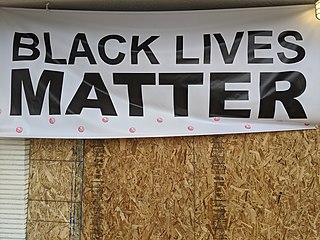
This is a list of protests that took place in Los Angeles County, California following the murder of George Floyd on May 25, 2020, in Minneapolis, Minnesota, while in police custody.
On June 24, 2021, a woman posted a video to Instagram in which she had confronted staff at Wi Spa, a Korean spa in Los Angeles, about the presence of a nude individual with a penis, most commonly believed to be a trans woman, in the women's changing area of the spa. The video went viral, attracting significant attention from trans-excluding feminists online and right-wing media, which led to protests and counter-protests on July 3 and 17 over the alleged access. Some media initially questioned whether the alleged incident had been a hoax.
References
- ↑ Anania, Billy (June 11, 2020). "The Los Angeles Paper That Documented Police Brutality in the 1960s and '70s". Hyperallergenic. Retrieved September 4, 2022.
Readership expanded so much after Watts that it devoted a special mid-week issue to the Century City police riots of 1967 — when unprovoked officers attacked Vietnam War protestors outside the Century Plaza Hotel as President Johnson launched his reelection campaign.
- ↑ Nichols, Steve. "Valley Voice: Recalling the Century City demonstration of 1967". The Desert Sun.
The protest, and the reaction of law enforcement agencies (later described as a "police riot")
- ↑ Rasmussen, Cecilia (August 5, 2007). "Closing of club ignited the 'Sunset Strip riots'". Los Angeles Times. Retrieved September 4, 2022.
- ↑ Chiland, Elijah (February 8, 2017). "50 years ago the first major gay rights demonstration happened in Silver Lake". Curbed Los Angeles. Curbed. Retrieved September 4, 2022.
- ↑ "A Poignant Scene-Draftee Says a Tender Goodby As Demonstrators March". Los Angeles Herald Examiner. Los Angeles, CA. May 4, 1966. Retrieved September 4, 2022.
- ↑ Reich, Kenneth (June 23, 1997). "The Bloody March That Shook L.A." Los Angeles Times. Retrieved September 4, 2022.
- ↑ Reich, Kenneth (June 23, 1997). "The Bloody March That Shook L.A." Los Angeles Times. Retrieved September 4, 2022.
- ↑ "LOS ANGELES POLICE ATTACK PEACEFUL ANTI-WAR MARCHERS". whenertheresafight.com. 2013. Archived from the original on 2016-03-04. Retrieved September 4, 2022.
- ↑ Reich, Kenneth (June 23, 1997). "The Bloody March That Shook L.A." Los Angeles Times. Retrieved September 4, 2022.
Reddin continues to maintain that there was ample reason to believe that major trouble was planned that night, including a possible storming of the hotel. Police came to this conclusion through intelligence provided by a private firm, International Investigations System, which was hired by the hotel and employed four undercover agents who worked closely with the LAPD. "One young woman succeeded in working her way into a position of secretary of Dorothy Healey, the chairperson of the Communist Party in Southern California," Reddin writes in his book chapter on the march. "Two young men got jobs as student workers which put them in close contact with members of the Students for a Democratic Society, one of the most militant groups involved in the event. The last, another young woman, managed to infiltrate the Peace Action Council by developing a close working relationship with Donald Kalish . . . vice chairman of the PAC." That agent, Sharon Stewart, 27 at the time of the march, could not be found this month. But it is obvious she was an important link in police assessments of the demonstrators' intentions. When the hotel went to court the day before the demonstration to obtain a court order restricting the march, it submitted an affidavit in which Stewart quoted Kalish and others as planning for disruptive "civil disobedience," despite their public assurances all would be peaceful.
- ↑ Masters, Nathan (October 27, 2011). "3 Protests from L.A. History That Got the Public's Attention". KCET. Retrieved September 4, 2022.
- ↑ "LOS ANGELES POLICE ATTACK PEACEFUL ANTI-WAR MARCHERS". whenevertheresafight.com. 2013. Archived from the original on 2016-03-04. Retrieved September 4, 2022.
- ↑ Reich, Kenneth (June 23, 1997). "The Bloody March That Shook L.A." Los Angeles Times. Retrieved September 4, 2022.
- ↑ Nichols, Steve. "Valley Voice: Recalling the Century City demonstration of 1967". The Desert Sun. Retrieved September 4, 2022.
I drove to the march route in Century City and dropped some family members off to join the procession. As I sought parking, traffic on Olympic Boulevard came to an abrupt standstill. Desperate screams came from the crowd of protesters crossing the overpass ahead on Avenue of the Stars, and in the next instant large numbers of them descended the steep embankment to Olympic, seeking refuge. Some were badly injured, blood streaming down their faces. Others were limping or tending to lesser wounds. The police had impeded the marchers (who had a permit), then had waded into the crowd swinging nightsticks. The embankment down to Olympic was one of the few ways for protesters to escape. Other motorists and I tried to get the worst injured into cars for transport to a hospital, but traffic wouldn't move. Ambulances were slow to arrive.
- ↑ Reich, Kenneth (June 23, 1997). "The Bloody March That Shook L.A." Los Angeles Times. Retrieved September 4, 2022.
Ed Davis, who would succeed Reddin as LAPD chief two years after the march, was deputy chief that night and was shocked by the department's conduct. Even today, the officer who was in charge of tactical planning for the demonstration--another chief-to-be named Daryl Gates--remembers the vehemence of Davis' protest. "I was in San Diego that night at an American Legion convention," said Davis, now in retirement in Morro Bay. "When I saw television on the thing, and I saw police officers beating people over the head with nightsticks, I went into the chief's office the following Monday, and I said, 'By what legal right did they have to do that?' "Chief Reddin was there, but it was his aide, Eddie Walker, who said, 'By virtue of the dispersal order' [that police had formally read to demonstrators when the march halted]. I got out the dispersal order, and it said you could arrest, not punish the demonstrators, and I voiced my very strong disapproval. "I'm sure the chief thought he had done a wonderful job, and Eddie Walker thought I was a Communist. But when [future President Richard] Nixon came out later and there was a Century Plaza demonstration when I was chief, we handled it differently, and I'm challenging they had no legal authority to use their clubs and beat people with them." Reddin said he could not recall such a conversation with Davis.
- ↑ Reich, Kenneth (June 23, 1997). "The Bloody March That Shook L.A." Los Angeles Times. Retrieved September 4, 2022.
- ↑ "Call for a National Anti-War Conference" (PDF). marxists.org. June 6, 1969.
- ↑ "Thousands of Mexican American antiwar activists march in Chicano Moratorium". HISTORY. A&E Television Networks. August 27, 2020. Retrieved September 4, 2022.
- ↑ Reich, Kenneth (June 23, 1997). "The Bloody March That Shook L.A." Los Angeles Times. Retrieved September 4, 2022.
- ↑ Nichols, Steve (June 28, 2020). "Valley Voice: Recalling the Century City demonstration of 1967". The Desert Sun. Retrieved September 4, 2022.